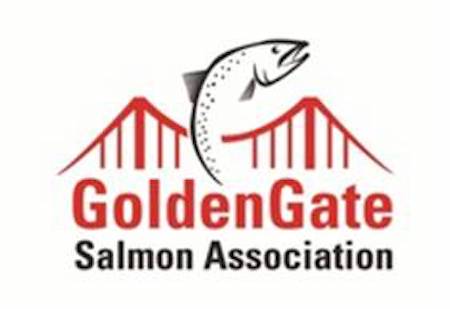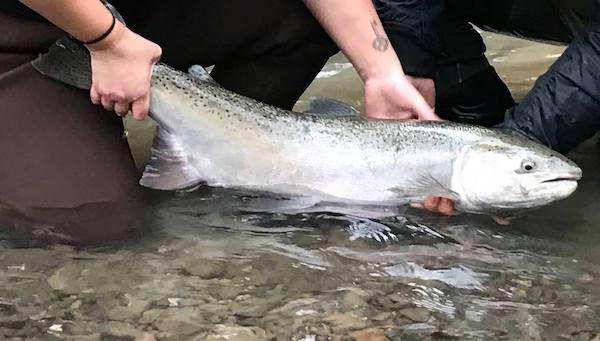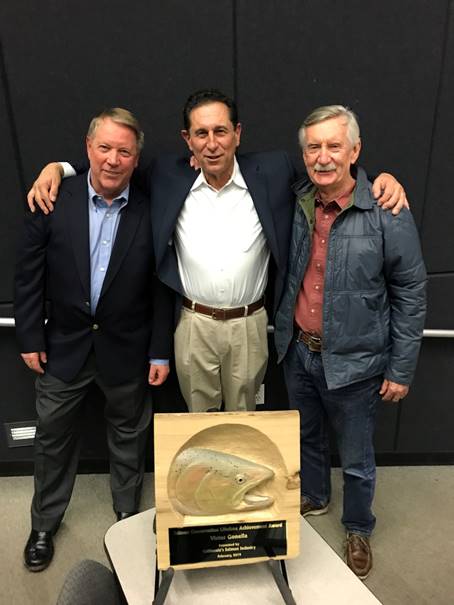From Sportfishing
Fish Report for 2-27-2019

Good Salmon Forecast for 2019 Suggests Plentiful Fishing
2-27-2019
Victor Gonella
Today officials forecast 379,632 adult Sacramento Valley salmon are now in the ocean off the West Coast, compared to 229,400 a year ago at this time. This suggests a return to relatively plentiful salmon fishing in 2019 is likely. In the month ahead, officials with the Pacific Fisheries Management Council will use this forecast and other information to set times and areas open to both sport and commercial ocean salmon fishing for 2019.
The reason for the uptick in this year’s salmon forecast is directly linked to the better Central Valley river conditions during the very wet spring of 2017. Increased natural runoff from rivers in the Central Valley always boost salmon survival, as measured two years later when the fish return to spawn as adults.
“We are looking forward to a good salmon fishing season this year,” said GGSA president John McManus.
In addition to the Sacramento salmon forecasts, more salmon from other Central Valley rivers and hatcheries, as well as from the Klamath and other north coast rivers, will add to ocean numbers.
“We could see the best season since 2013, which was a really good one,” said GGSA director and publisher of USA Fishing.com Mike Aughney. “Then as now, the good times came two years after really wet winters and springs in the Central Valley. If water managers would leave more water in the rivers during some of the drier years, we’d always have more salmon.”
Since baby salmon are considered one year old when they leave the Central Valley in the spring, and most return as three year old adults, you can always count on good fishing two years after lots of rain and snow. (Yes, with this year’s rain and snow, 2021 should be a good year too!)
The less good news is that the number of adult salmon that returned to the Sacramento Valley to spawn in 2018 fell short of targets for the fourth year in a row. After three years of missing the target, the National Marine Fisheries Service increased the so-called minimum escapement target from 122,000 to 151,000 fish in 2018. They may do the same again this season which could result in a shortened season or some areas being closed. These decisions will be made over the next month but no matter what, most expect good fishing once the season finally gets under way.
In spite of the relatively rosy 2019 forecasts, the entire Central Valley is still recovering from the last great drought which greatly reduced salmon in various Central Valley tributaries. A few years of good returns to help rebuild the natural spawning stocks is welcome news.
“Drought could revisit us almost anytime, in fact it’s probably just a matter of when. We need to build and fortify in the good years so we don’t get wiped out again in the bad,” said GGSA secretary Dick Pool. “That’s why GGSA is working overtime to get salmon recovery, habitat improvements, and hatchery improvements on the new governor’s radar.”
Over diversion of the Central Valley rivers in years with less rainfall is a major reason for declines in the salmon population. The State Water Resources Control Board is currently trying to rebalance how water is shared in the Central Valley. GGSA is working to make sure the needs of salmon are heard in this process.
The Golden Gate Salmon Association (www.goldengatesalmon.org) is a coalition of salmon advocates that includes commercial and recreational salmon fisherman, businesses, restaurants and chefs, a native tribe, environmentalists, elected officials, families and communities that rely on salmon. GGSA’s mission is to restore California salmon for their economic, recreational, commercial, environmental, cultural and health values
Currently, California’s salmon industry is valued at $1.4 billion in annual economic activity in a normal season. The industry employs tens of thousands of people from Santa Barbara to northern Oregon. This is a huge economic bloc made up of commercial fishermen, recreational fishermen (fresh and salt water), fish processors, marinas, coastal communities, equipment manufacturers, tackle shops and marine stores, the hotel and food industry, tribes, and the salmon fishing industry at large. Salmon are a keystone species that reflect the health of both their fresh and salt water environments.
< Previous Report Next Report >
More Reports
Reminded of What Healthy Rivers can Look Like
Coastal Streams
2-25-2019
At this time of year coastal rivers are visited by a close cousin to salmon; steelhead. It's great to be...... Read More

2-20-2019
On February 16, friends, associates, fellow fishermen, and dignitaries gathered at the Bodega Marine Lab in Bodega Bay to honor...... Read More

Website Hosting and Design provided by TECK.net